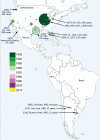Reemergence of St. Louis Encephalitis Virus in the Americas
- PMID: 30457961
- PMCID: PMC6256408
- DOI: 10.3201/eid2412.180372
Reemergence of St. Louis Encephalitis Virus in the Americas
Abstract
We summarize and analyze historical and current data regarding the reemergence of St. Louis encephalitis virus (SLEV; genus Flavivirus) in the Americas. Historically, SLEV caused encephalitis outbreaks in the United States; however, it was not considered a public health concern in the rest of the Americas. After the introduction of West Nile virus in 1999, activity of SLEV decreased considerably in the United States. During 2014-2015, SLEV caused a human outbreak in Arizona and caused isolated human cases in California in 2016 and 2017. Phylogenetic analyses indicate that the emerging SLEV in the western United States is related to the epidemic strains isolated during a human encephalitis outbreak in Córdoba, Argentina, in 2005. Ecoepidemiologic studies suggest that the emergence of SLEV in Argentina was caused by the introduction of a more pathogenic strain and increasing populations of the eared dove (amplifying host).
Keywords: Americas; South America; St. Louis encephalitis virus; United States; arbovirus; emerging infectious disease; phylogeography; viruses.
Figures


Similar articles
-
Reemergence of St. Louis Encephalitis Virus, California, 2015.Emerg Infect Dis. 2016 Dec;22(12):2185-2188. doi: 10.3201/eid2212.160805. Emerg Infect Dis. 2016. PMID: 27869600 Free PMC article.
-
Evaluation of Argentinean Bird Species as Amplifying Hosts for St. Louis Encephalitis Virus (Flavivirus, Flaviviridae).Am J Trop Med Hyg. 2018 Jul;99(1):216-221. doi: 10.4269/ajtmh.17-0856. Epub 2018 May 10. Am J Trop Med Hyg. 2018. PMID: 29761767 Free PMC article.
-
Activity Patterns of St. Louis Encephalitis and West Nile Viruses in Free Ranging Birds during a Human Encephalitis Outbreak in Argentina.PLoS One. 2016 Aug 26;11(8):e0161871. doi: 10.1371/journal.pone.0161871. eCollection 2016. PLoS One. 2016. PMID: 27564679 Free PMC article.
-
Saint Louis Encephalitis Virus, another re-emerging arbovirus: a literature review of worldwide research.Infez Med. 2017 Mar 1;25(1):77-79. Infez Med. 2017. PMID: 28353461 Review.
-
St. Louis encephalitis: lessons from the last decade.Am J Trop Med Hyg. 1987 Nov;37(3 Suppl):40S-59S. doi: 10.4269/ajtmh.1987.37.40s. Am J Trop Med Hyg. 1987. PMID: 3318523 Review.
Cited by
-
Phenotypical Screening of an MMV Open Box Library and Identification of Compounds with Antiviral Activity against St. Louis Encephalitis Virus.Viruses. 2023 Dec 13;15(12):2416. doi: 10.3390/v15122416. Viruses. 2023. PMID: 38140657 Free PMC article.
-
Forecasting Zoonotic Infectious Disease Response to Climate Change: Mosquito Vectors and a Changing Environment.Vet Sci. 2019 May 6;6(2):40. doi: 10.3390/vetsci6020040. Vet Sci. 2019. PMID: 31064099 Free PMC article. Review.
-
Assessment of Culex pipiens bioforms in the world's southernmost distribution limit.Mem Inst Oswaldo Cruz. 2020 Feb 7;115:e190390. doi: 10.1590/0074-02760190390. eCollection 2020. Mem Inst Oswaldo Cruz. 2020. PMID: 32049099 Free PMC article.
-
Usutu Virus: An Arbovirus on the Rise.Viruses. 2019 Jul 12;11(7):640. doi: 10.3390/v11070640. Viruses. 2019. PMID: 31336826 Free PMC article. Review.
-
Applications and advancements in animal models for antiviral research on mosquito-borne arboviruses.Animal Model Exp Med. 2024 Oct;7(5):673-684. doi: 10.1002/ame2.12471. Epub 2024 Jul 10. Animal Model Exp Med. 2024. PMID: 38987937 Free PMC article. Review.
References
-
- Chamberlain RW. History of St. Louis encephalitis. In: Monath TP, editor. St. Louis encephalitis. Washington (DC): American Public Health Association; 1980. p. 680.
-
- Monath TP, Tsai TF. Flaviviruses. In: Richman DD, Whitley RJ, Hayden FG, editors. Clinical Virology. New York: Churchill-Livingstone; 1997. p. 1133–86.

